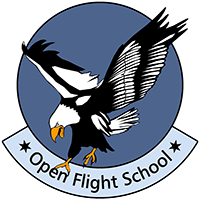Main Glossar
Special | A | B | C | D | E | F | G | H | I | J | K | L | M | N | O | P | Q | R | S | T | U | V | W | X | Y | Z | ALL
D |
|---|
Discord | |||
|---|---|---|---|
Discord ist eine Software mit der man Server zu bestimmten Themen einrichten kann und dort Text-Kanäle (Chat-Räume) und Sprach-Kanäle (für Audio-Konferenzen ala TeamSpeak) anbieten kann. Auch die Übertragung des eigenen Bilschirms (Streaming) ist möglich. Da man die Discord-App für alle möglichen Betriebsysteme und auch als App für Smartphones installieren kann, ist es für unsere Belange sehr gut geeignet. Wenn du bei der OpenFlightSchool mitmachen möchtest (egal ob als Schüler oder als Tutor) dann solltest du unserem Discord-Server beitreten. Um das zu tun klicke einfach auf folgenden Link: | |||
DLC | |||
|---|---|---|---|
Direct Lift Control (dt.: direkte Auftriebskontrolle) Das DLC ist ein System von Klappen die im Landeanflug verwendet werden können, um den Auftrieb zu verändern ohne den AOA zu beeinflussen. Gesteuert werden die Klappen über einen Schalter am HOTAS Steuerknüppel. Weiterführende Informationen:
| |||
DSMS | |||
|---|---|---|---|
DSMS Digital Stores Management System | |||
E |
|---|
EAC | |||
|---|---|---|---|
ECS | |||
|---|---|---|---|
(AH-64D Apache) Environmental Control System The ECS provides crewmember comfort through ventilation, heating, and air conditioning. Ventilation is provided by pilot and CPG gaspers, which can be opened to admit outside air into the cockpit. The ECS also powers ventilation fans that provide forced air exchange between the cockpits and for avionics cooling. | |||
ECU | |||
|---|---|---|---|
(AH-64D Apache) Electronic Control Unit Detects overspeed and overcurrent anomalies, as well as abnormal oil pressure. The ECU will automatically shut down the APU when an anomaly is detected. The ECU also controls the power takeoff (PTO) clutch engagement to the accessory section of the main transmission. | |||
EEG | |||
|---|---|---|---|
Electronic Engine Governor The electronic engine governor controls the fuel flow to the engines so that the pilot does not have to operate the engine throttle when controlling the collective. Further Information: KA-50 Black Shark Basic Course (DCS) / Cockpit Instruction / Cockpit Overview / SP | |||
EEP | |||
|---|---|---|---|
Electrical Power Panel (dt.: Kontrollen für die elektrischen Systeme) EEP ist keine "offizielle" Abkürzung, wird in unseren Kursen aber verwendet. Weiterführende Informationen:
| |||
EGI | |||
|---|---|---|---|
EGT | |||
|---|---|---|---|
The Exhaust Gas Temperature of a jet engine is one of two primary measurements of engine performance. The temperature is usually measured at the Power Turbine that drives a shaft through the centre of the engine to spin the blades of the multi-stage compressor. Additional Information: | |||
EKRAN | |||
|---|---|---|---|
EPMS | |||
|---|---|---|---|
(AH-64D Apache) Electrical Power Management System Electrical aircraft power is managed by the EPMS. The EPMS is a fully redundant and automatic power system consisting of a distributor for battery, AC, and DC power. | |||
F |
|---|
FCS | |||
|---|---|---|---|
Flight Control System The Flight Control System includes:
Further information:
| |||
FEEL | |||
|---|---|---|---|
Fuel, Engine, Electrics, Location A method of ensuring the aircraft has sufficient fuel for the task, is operating correctly and that you know where you are. All AircraftFUEL - Check the quantity against the expected quantity at that stage of the flight. Consider this as an amount up or down and compare that to the wind you have experienced so far. Also ensure that the fuel tanks are in balance and correct with fuel transfer if needed. ENGINE - Check the engine instruments for any fluctuations or unusual readings. ELECTRICS - Check the generator is providing charge to the battery. LOCATION - Check your location is as you expect and you know where the nearest air station is in the case of an emergency. Modern AircraftThe additional systems of a modern aircraft often require a little more than just the above FEEL. Consider this as FEEL+ and can include things like: HYDRAULICS - Check the Temperature and Pressure OXYGEN - Check the contents, flow and pressure CABIN - Check the Pressurisation and Temperature Combat SituationsAgain, Combat situations may require further checks, see Fence In and Fence Out RepetitiveThese checks should be conducted about every 20 mins (as a minimum after each 30 mins) or after each change of altitude or turning point of a navigation exercise. | |||
FF | |||
|---|---|---|---|
FLIR | |||
|---|---|---|---|
Forward Looking Infrared A camera operating in the Infrared spectrum. Able to display heat images and so give a thermal representation of the viewed scene. Often in a flight wing/fuselage pod. can be slewed from the cockpit. Function can include zoom, tracking, black or white hot etc. | |||
FM | |||
|---|---|---|---|
FMC | |||
|---|---|---|---|
(AH-64D Apache) Flight Management Computer The FMC provides rate damping to smooth flight control inputs and command augmentation. It also provides limited attitude and altitude hold capability for hands-off flying. | |||
FOD | |||
|---|---|---|---|
steht für Foreign Object Debris (dt. Beschädigung durch Fremdkörper). Weiter Infos: | |||

